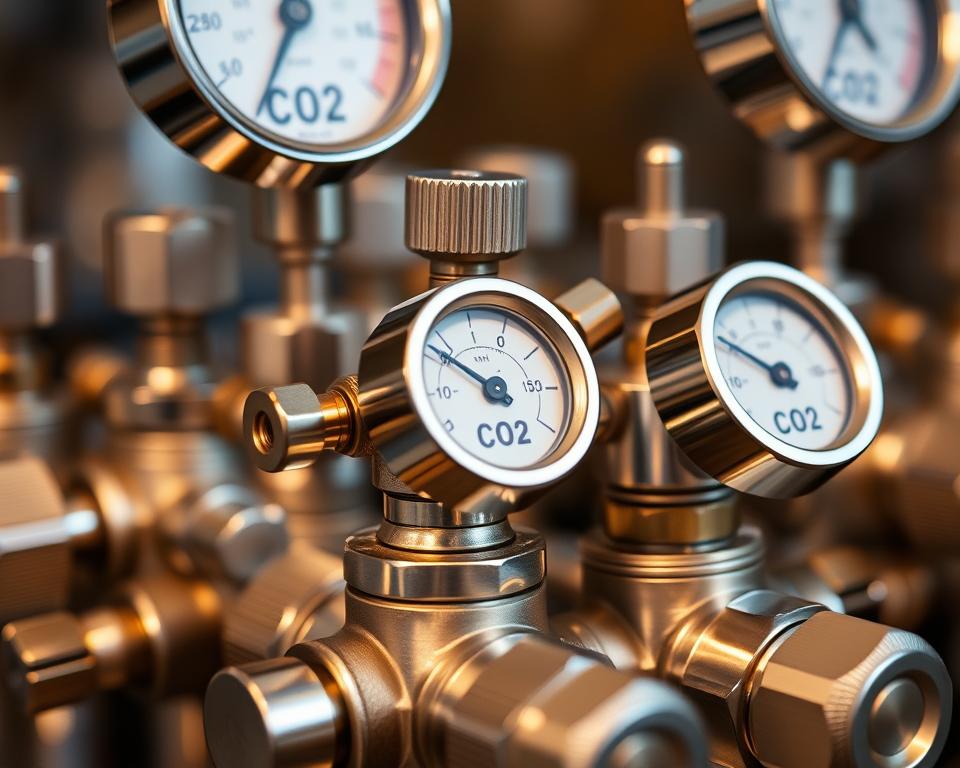CO2 Regulator Fittings – Vital Handbook & Tips
Were you aware that main regulators in CO2 systems cut tank pressure from 800-900 psi to a more controllable 10-30 psi? This not only showcases the capability of CO2 regulator fittings but underscores their indispensable role in ensuring a perfect pour. They play a key role in settings like kegerators, aquariums, and industrial settings. Grasping CO2 fittings is fundamental for optimal operation and dependability.
CO2 regulator fittings greatly influence the standard and taste of carbonated drinks. Opting for high-quality CO2 regulator fittings can maintain consistent gas pressure, preventing over or under-carbonated beer issues. It’s important to select top-notch CO2 fittings from well-known sources like Installation Parts Supply. This ensures endurance and efficiency. We will discuss various fitting variants, setup tips, upkeep suggestions, and decision-making tactics for particular requirements.
Principal Conclusions
- Primary regulators play a critical role in lowering high CO2 tank pressure for ideal serving.
- Various beer styles necessitate distinct carbonation settings to achieve the best flavor.
- Steady gas pressure is vital to avoid excessively or insufficiently carbonated beverages.
- Secondary regulators play a key role when serving multiple kegs at diverse pressures.
- Opting for premium fittings from renowned brands can enhance system reliability.
Getting Started with CO2 Regulator Fittings
CO2 regulator fittings are crucial in controlling carbon dioxide flow and pressure throughout multiple fields. These include beverage dispensing, fish farming, and healthcare applications. They transform the CO2 pressure from a elevated range (800 to 1000 PSI) to a more regulated range (1 to 40 PSI). This conversion is essential for the reliable operation of CO2-dependent devices.
The primary parts of CO2 regulator fittings are the regulator and the shut-off valve. The regulator maintains desired pressure levels, while the shut-off valve supplies manual gas flow control. A important safety feature is the check valve. It works to stop back-siphoning, preserving the system’s integrity. In aquarium settings, securing stable pH levels through precise CO2 delivery is vital. Tools such as bubble monitors and pH regulators play a significant role in this process, ensuring healthy plant growth.
Choosing reliable CO2 regulator fittings is vital for optimal performance in varied environments. When choosing fittings, it’s imperative to evaluate the match of materials with CO2. For example, silicone tubing can enable gas to seep out, which can lead to losses. Choosing top-grade needle valves can prevent issues such as ‘end of tank dumps.’ This ensures safety and maintains consistent CO2 delivery.
How CO2 Regulator Fittings Operate
CO2 regulator fittings are essential for the efficiency and security of CO2 systems. They help maintain uniform pressure, key to proper carbonation in refreshments. High-pressure CO2 tanks, storing 800 to 900 psi, need their pressure reduced to a controllable 10-30 psi. This pressure drop is key to serving at the optimal carbonation levels. Key regulators, integral components in CO2 regulator fittings, facilitate this process. They frequently include a gauge or dual gauges to monitor the gas pressure.
Regarding serving beer, the functionality of these fittings becomes paramount. Uneven pressure may impair the excellence of the pour. Consequently, the outcome may be beer that’s either over-carbonated or lacking carbonation. Given that distinct beer types require distinct carbonation levels, like stouts needing less than lagers, additional regulators are essential. They allow for adjustments based on the particular demands of each keg.

For serving on the go, such as with smaller 74 gram CO2 tanks, mobile beer regulators are perfect. They make it feasible to serve a minimal arrangement, efficiently serving a 1/4 barrel. Choosing dependable CO2 system regulator fittings is critical. Examples include Taprite are well-known for reliable regulators, enhancing the brewing operation.
| Regulator Type | Pressure Range | Application |
|---|---|---|
| Primary Regulator | 10-30 | Ideal for standard beer serving |
| Dual Gauge Regulator | 0-60 | Shows both tank and output pressures |
| Secondary Regulator | Fluctuates | Ideal for serving multiple kegs |
| Mobile Beer Regulator | 10-14 | Connects to small tanks for portable serving |
A deep understanding of the roles and specs of CO2 regulator fittings can improve a serving setup. Frequently inspecting pressure gauges and fittings ensures that the system functions perfectly. This diligence leads to superior service quality.
Categories of CO2 Regulator Fittings
As you select CO2 regulator fittings, it’s essential to know the types available for maximum efficiency in different scenarios. The main types are single gauge and dual gauge regulator fittings. Each fulfills specific roles, addressing the demands of a range of applications from entry-level home brewing to intricate industrial operations.
Single Gauge Regulator Fittings
Intended for basic tasks, single gauge regulator fittings are tailored to manual adjustment needs. They come with a single gauge displaying the gas’s output pressure. Well-suited to small-scale projects like home kegerators or small breweries, they offer a straightforward approach. Manufacturers like Brewmaster and Fermentap stand out for providing simple and efficient solutions.
Dual Gauge Regulator Fittings
Dual gauge regulator fittings are equipped to offer more precise measurement by displaying both the output and the remaining tank pressure. They are vital for advanced operations, including industrial brewing. This double indication helps users avoid potential disasters like keg explosions or gas leaks. For those demanding higher accountability, manufacturers such as KOMOS and Taprite offer a wide selection of dual gauge options.
| Variety | Advantages | Recommended Usage | Example Brands |
|---|---|---|---|
| Single Gauge Regulator Fittings | Ease and simplicity | Domestic setups, compact systems | Brewmaster & Fermentap |
| Dual Gauge Regulator Fittings | Precise pressure monitoring | Professional and multi-keg systems | KOMOS / Taprite |
Choosing the Best CO2 Regulator Fittings for Your Needs
Opting for the ideal CO2 regulator fittings requires critical considerations. These considerations boost the CO2 system’s functionality and security. First, assess the pressure range that meets your application, ensuring the fittings handle the required pressure levels. It’s essential to confirm compatibility with CO2 sources like CGA-320 valves for a smooth connection. Also, focus on durability to prevent leaks and malfunctions in your CO2 system.
Key Considerations for Fitting Selection
- Pressure Range: The fittings need to support your system’s PSI needs.
- Material Quality: Opt for corrosion-resistant materials, such as stainless steel, for longevity.
- Fit: Ensure the fittings are suitable for your CO2 sources.
- Ease of Installation: Look for designs that are easy to install.
Recommended Brands for High-Quality CO2 Fittings
Emphasizing well-established brands is crucial for optimal performance and reliability. Installation Parts Supply is noted for supplying top-notch CO2 regulator fittings. Their offerings combine quality and cost, suiting both hobbyists and professionals. The Milwaukee MA955 solenoid, with a price near $40 CAD, is noted for its effective functioning. Additionally, the Aqualabs regulator and the Dici regulator with a bubble counter are economical, priced at $50 to $60 CAD on Amazon. These brands are excellent choices for enhancing your aquarium system.
How to Install CO2 Regulator Fittings
Setting up CO2 regulator fittings demands a keen attention to intricate details and adherence to essential safety measures. Proper setup secures that the system works efficiently. It also prevents leaks that could create danger. To ensure a safe and efficient installation of CO2 regulator fittings, keep these tips in mind:
- First, verifying the control valve. Confirm it is in the off position before continuing with installation, as this stops unexpected gas discharge during the fitting process.
- Apply appropriate sealing techniques to all threaded joints. Teflon tape serves as an effective solution to ensure a secure fit without risk of leakage.
- Adjust the pressure settings on your CO2 regulator correctly, which is crucial for achieving optimal carbonation levels and preventing excessive pressure that could damage your system.
- Once connections are complete, a sequential venting of gas is necessary to ensure correct pressure measurement and eliminate any residual air.
- Once installed, perform a comprehensive leak check. A soapy water solution is effective for spotting leaks, ensuring your system operates safely.
By adhering to these installation tips, you can substantially improve both the performance and security of your CO2 system.
CO2 Regulator Parts: Maintenance and Troubleshooting
For optimal CO2 regulator performance, consistent upkeep and prompt problem-solving are essential. Frequent checks help spot problems early on. Leak detection is critical. Using soapy water to test for leaks is effective, as bubbling signals a repair requirement.
Ensuring proper torque on internal components is vital, with a 7/8 socket wrench recommended for a secure fit. Securing the regulator properly enhances longevity. After putting the bonnet back, 75 foot/lbs of torque is recommended. After repair, the regulator should read above 40 PSI. Sometimes, an additional 1/4 turn is required for proper pressure.
Faulty installation or absent washers frequently lead to leaks, draining CO2 tanks quickly. Pressure relief valves should activate under 60 PSI for beer regulators. However, there can be instances of release at higher pressures. Diaphragm or cartridge failure often necessitates regulator rebuilds.
Brands differ in their operational characteristics. The Milwaukee MA957, popular yet critiqued for needle valve issues, has a 6-month warranty. A 5-year warranty from CMBecker underscores product reliability.
Proper maintenance extends CO2 systems’ lifespan. Familiarity with your regulator’s parameters, for instance Taprite’s 0-50 PSI, helps with repairs. Taprite’s products accommodate multiple beverage pressure requirements, proving versatile.
Budget CO2 Fittings vs. High-End CO2 Regulator Fittings
Deciding on affordable CO2 fittings and top-tier CO2 regulator fittings depends on their cost. Basic options are available from $20, whereas high-quality products often are priced from $200. To illustrate, a economical CO2 setup with a basic regulator attached to a standard 5 lb cylinder could cost between $150 to $175. Alternatively, a high-end CO2 system could be priced as high as $625, subject to the brand and quality level.
The dependability of CO2 systems largely depends on the quality of their components. Users note that high-grade regulators enable precise pressure control, vital for sub-10 gallon tanks. Furthermore, over 50% of users favor fully assembled setups, valuing ease of use and assured quality. When components are compiled by companies, rather than manufactured, prices may vary significantly.
There’s potential for savings when individuals opt to buy parts separately and assemble themselves by around 20-30% relative to complete kits. The prices of components like solenoids and metering valves differ greatly. Solenoids can cost between $20 and $50, while metering valves can range from $17 to more than $200, depending on their quality and function.
At about $60, a 5 lb aluminum CO2 tank is a factor in the total expense. Feedback on products like the KOMOS® Premium Dual Gauge CO2 Regulator, priced at $59.99, is mixed. It functions up to 60 PSI with a maximum flow rate that is not specified. This regulator includes a pressure release valve set to activate at 65 PSI.
In terms of durability and efficiency, nearly 70% of users are pleased and about 80% would endorse it for homebrewing. Despite this, there are concerns such as slow leaks, experienced by 10% of users. Investing extra is driven by the need for reliable performance, a key factor in selecting between economical and premium CO2 regulator fittings.
As a Final Point
Selecting the appropriate CO2 regulator fittings is essential for your system’s performance, integrity, and cost-effectiveness. We have outlined key considerations, including varieties of CO2 regulator fittings and points to consider in your choice. An appropriate regulator is essential for consistent carbonation in draft beer and long-term system dependability.
While premium fittings may cost more initially, they offer enhanced durability and simpler maintenance. High-quality brands like Airgas, Taprite, and Micromatic offer superior reliability. They help meet the unique demands of different users, ensuring long-term satisfaction and performance.
It is recommended to consult trusted suppliers like Installation Parts Supply when setting up or upgrading a CO2 system. Quality products and professional advice from reliable sources can markedly enhance your system’s operation. Investing in quality fittings pays off in the performance of both domestic and commercial CO2 systems.
FAQ
What do CO2 regulator fittings do and why are they important?
CO2 regulator fittings control the flow and pressure of CO2 in systems such as kegerators, aquariums, and diverse systems. They play a crucial role in guaranteeing the system’s functionality and reliability by maintaining CO2 levels.
Which types of CO2 regulator fittings exist?
The primary types are single gauge and dual gauge regulator fittings. Single gauge fittings are designed for basic applications such as home kegerators, providing straightforward control. Alternatively, dual gauge fittings offer precise monitoring for complex or industrial systems.
How can I choose the most suitable CO2 regulator fittings for my needs?
Choosing the right CO2 regulator fittings involves considering the required pressure levels, fit with your CO2 supply, and build standards. Ensure high durability and safety to minimize issues and maintain efficiency.
Can you suggest trusted brands for CO2 regulator fittings?
Brands like Installation Parts Supply offer top-quality CO2 regulator fittings. Selecting well-known brands ensures both safety and efficiency.
Can you provide installation guidelines for CO2 regulator fittings?
Make sure every connection is secure and leak-free during installation. Set the correct pressure and follow a sequential gas venting process for precise measurements. Consult detailed installation guides for further assistance.
What maintenance practices are important for CO2 regulator fittings?
Routine care is key to keeping your system in peak condition. Monitor for leaks, adjust pressure as needed, and resolve common problems promptly. Following these guidelines maintains system performance.
Is it worthwhile to invest in high-end CO2 regulator fittings?
Definitely, top-tier fittings from reputable manufacturers can lead to savings by minimizing repair and replacement needs. They provide enhanced performance and improved operational consistency.


